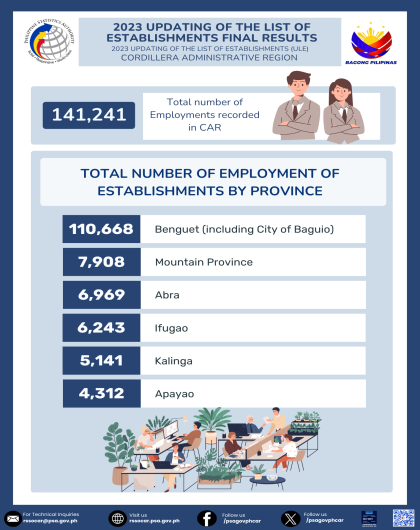The List of Establishments (LE) is a register of businesses operating in the country. The LE provides statistics on the number of establishments (old and new) and the basic characteristics of businesses useful in the economic planning and decision-making of the government and the private sector. The updating of the LE is conducted annually to provide a sampling frame for the establishment-based censuses and surveys.
Cordillera shares 2.1% of total establishment in the country
- In 2016, there were 915,726 establishments in the country employing about 7.7 million persons in 17 geographical regions.
- About 2.1 percent or 18,992 of these establishments were in the Cordillera Administrative Region (CAR). These establishments employed about 106,788 persons.
Table 1. Number of Establishments and Employment in CAR by Province: 2016
| Region/Province | Number of Establishments | % Share to Total Employments | Number of Employment | % Share to Total Employment |
|---|---|---|---|---|
| Philippines | 915,726 | 7,710,908 | ||
| CAR | 18,992 | 100 | 106,788 | 100 |
| Abra | 1,237 | 6.5 | 5,075 | 4.8 |
| Apayao | 364 | 1.9 | 1,305 | 1.2 |
| Benguet | 13,560 | 71.4 | 88,669 | 83.0 |
| Ifugao | 839 | 4.4 | 2,660 | 2.5 |
| Kalinga | 1,532 | 8.1 | 5,518 | 5.2 |
| Mt. Province | 1,460 | 7.7 | 3,561 | 3.3 |
- Benguet including Baguio City had the highest number of establishments with 13,560. These establishments accounted 71.4 percent of the total establishments in the region. These establishments employed a total of 88,669 persons contributing to 83.0 percent to the total employments in CAR.
-
Kalinga had the second highest number of establishments with 1,532 or 8.1 percent of the total number of establishments in CAR. These establishments shared 5.2 percent to the total employment in the region with about 5,518 employed persons.
-
Mountain Province had 1,460 establishments, comprising 7.7 percent of the total regionwide and employing 3,561 persons. Abra had 1,237 establishments (6.5%) with 5,075 employees. Ifugao had 839 establishments (4.4%) with 2,660 employees. Apayao had the least with 364 establishments (1.9%) employing 1,305 persons.
- The 2009 Philippine Standard Industrial Classification (PSIC) provides a detailed classification of industries prevailing in the country according to the kind of productive activities undertaken by establishments. The LE covers economic activities under the 18 industry sections (Figure 1) defined in the PSIC including establishments based on their Economic Organization (EO), Legal Organization (LO), and establishment size.
-
By industrial classification, Wholesale and Retail Trade; and Repair of Motor Vehicles and Motorcycles (Section G) dominated the establishment count in CAR with 8,371 establishments. These comprised 44.1 percent of the total establishments in the region.
-
Accommodation and Food Service (Section I) was at 17.7 percent or 3,369 establishments; while Manufacturing (Section C) was at 11.7 percent or 2,216 establishments.
-
Electricity, Gas, Steam and Air Conditioning Supply (Section D), Mining and Quarrying (Section B), and Water Supply, Sewerage, Waste Management and Remediation activities (Section E) had the least number with 42, 18, and 15 establishments, respectively.
- In terms of economic organization, majority of the establishments in CAR were classified as Single Establishments (EO=1) with 16,624 establishments, comprising 87.5 percent of the total establishments in the region. Branch Only (EO=2) came next with 9.6 percent (1,829 establishments) and Establishment and Main Office (EO=3) with 2.3 percent (433 establishments). Meanwhile, the Ancillary Unit (EO=5) and the Main Office Only (EO=4), had the least number at 0.3 percent (62 establishments) and 0.2 percent (44 establishments) respectively.
Single Proprietorship comprises 88% of the total establishments regionwide
- As to legal organization, Single Proprietorship had the largest number with 16,627 establishments, sharing 87.5 percent of the total establishments in the region. Stock Corporation placed second with 7.6 percent or 1,452 establishments, followed by Non-stock, Non-profit Corporation and Partnership at 1.7 and 0.9 percent (323 and 174 establishments), respectively. Government Corporations and Others had the least number at 0.2 percent.
Micro enterprises are the biggest employer
- The size of an establishment is determined by its total employment. Majority of the establishments in CAR, 93.1 percent or 16,991 of these were Micro Enterprises or businesses with less than ten employees. These establishments employed about 46,155 persons. These comprised 43.2 percent from the total106,788 employment in the region in 2016.
-
Small Enterprises or small establishments that have 10-99 employees shared 6.5 percent with 24,899 employed persons from 1,196 establishments.
-
Medium Enterprises or enterprises with 100 or more employment had the least number with 37 establishments (0.2%) employing 5,627 workers.
-
There were 42 establishments operating under Large Scale or those with 200 and over number of employees. These establishments employed 30,969 persons representing a 29.0 percent of the total employment in the region.
| Size | Number of Establishments | % Share to Total Employments | Number of Employment | % Share to Total Employment |
|---|---|---|---|---|
| Micro | 17,690 | 93.1 | 46,155 | 43.2 |
| Small | 1,220 | 6.4 | 24,807 | 23.2 |
| Medium | 37 | 0.2 | 4,857 | 4.5 |
| Large | 45 | 0.2 | 30,969 | 29.0 |
-
The average numbers of employees per establishment size were: 3 workers in Micro, 20 workers in Small, 131 workers in Medium, and 688 workers in Large Scale Enterprises.
Technical Notes


